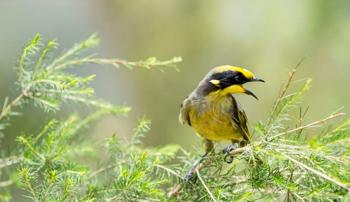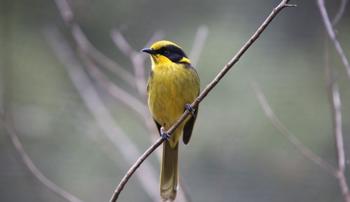Helmeted Honeyeater
The bird emblem of Victoria, the Helmeted Honeyeater (or HeHo for short) is a critically endangered, endemic sub-species of the Yellow-tufted Honeyeater.
Their current wild range is restricted to two locations with streamside swamp forest in the Yarra Valley, east of Melbourne. The birds have distinctive yellow, black and olive body feathers, and a crown of yellow feathers on their head which resembles a helmet (hence their name!).

Major threats
Loss of habitat due to agriculture is the primary threat to the Helmeted Honeyeater. They need to live close to water, and unfortunately areas with suitable swamp forest habitat are lacking. Climate change, drought, bushfire, and competition from other birds also endanger their existence.

The plan for fighting extinction
A recovery program for the Helmeted Honeyeater commenced in 1989 along with a conservation breeding program based at Healesville Sanctuary. Captive bred birds are released into the wild to supplement existing sites and to establish additional populations. Zoos Victoria is involved in monitoring their survival after release.
Our program also includes working with partners to create more honeyeater habitat and to establish a stable wild population at ten distinct but inter-connected colonies.
How you can help
- Do what you can to create community awareness and support for the Helmeted Honeyeater.
- Become a member or volunteer with the Friends of the Helmeted Honeyeater Inc.
- Include Indigenous plants in your garden to support Helmeted Honeyeater habitat
- Visiting our zoos supports our work to fight extinction.
- Donate if you can. As a not-for-profit organisation, all donations go towards our important conservation efforts.
Is your classroom learning about the Helmeted Honeyeater?
Browse through our collection of animal teaching and learning resources for students. These include animal toolkits, e-books, Ask a Zoo Expert resources, video showcases and real-world examples to support the VCE Study Design.
